Analyzing Occupational Health and Fitness in a Nursing Case Study
VerifiedAdded on 2022/08/10
|9
|2311
|404
Case Study
AI Summary
This case study examines the occupational health and fitness of a veterinary nurse, Jane, who is experiencing chronic fatigue syndrome (CFS). The study explores the causes and symptoms of CFS, including its impact on mental and physical well-being. It delves into Jane's work environment, highlighting her exposure to various hazards and the challenges of long hours and shift work. The analysis includes functional and biopsychosocial approaches to assess Jane's condition, and proposes a rehabilitation plan involving physiotherapy, psychological therapies, and energy conservation techniques. Furthermore, the study discusses relevant health and safety regulations, such as the Health and Safety at Work Act 1974, and the Control of Substances Hazardous to Health Regulations 2002, emphasizing the importance of a safe and healthy work environment for healthcare professionals. The study emphasizes interventions such as smoking cessation programs and recreational activities to reduce depression and anxiety related to fatigue.
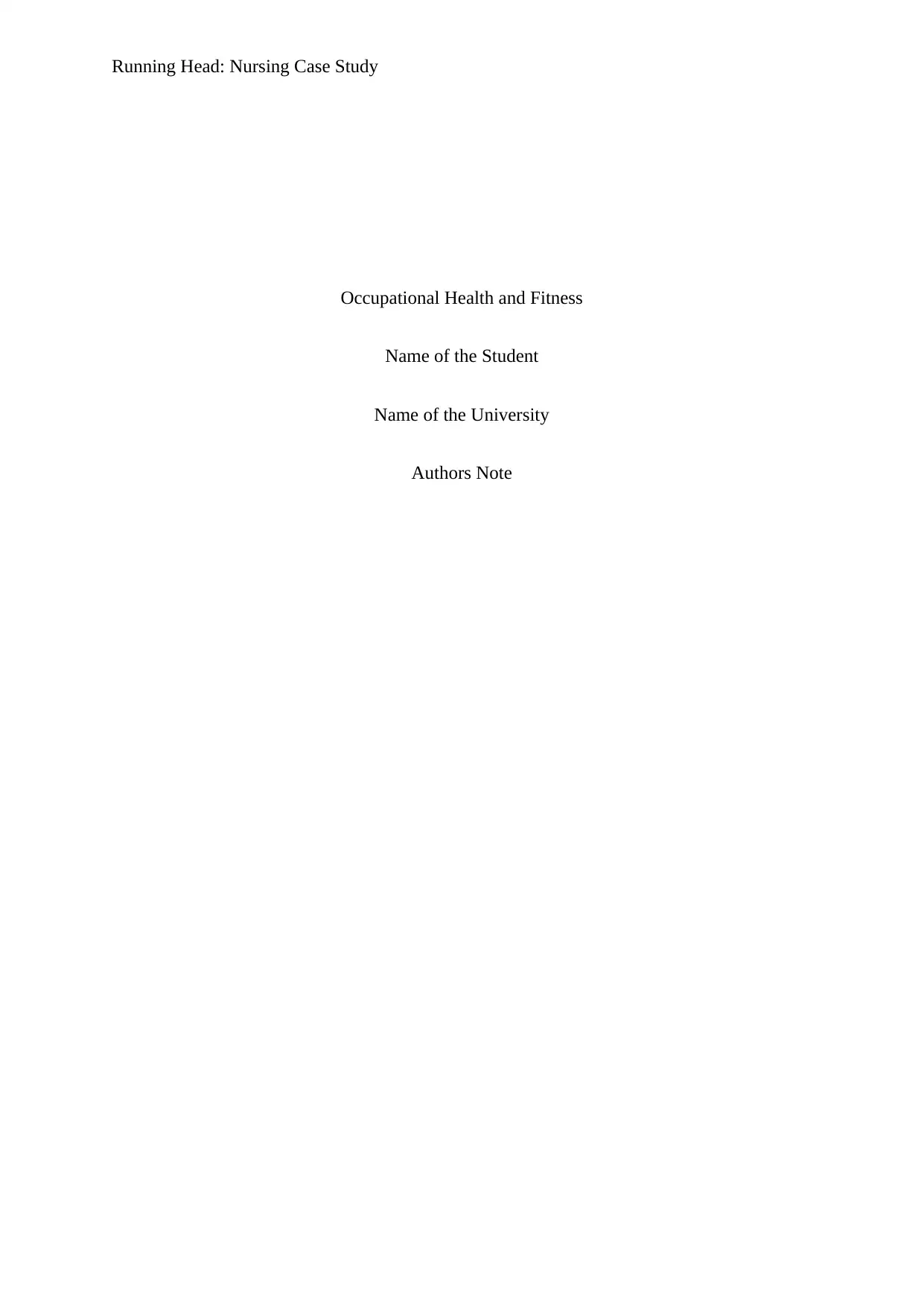
Running Head: Nursing Case Study
Occupational Health and Fitness
Name of the Student
Name of the University
Authors Note
Occupational Health and Fitness
Name of the Student
Name of the University
Authors Note
Paraphrase This Document
Need a fresh take? Get an instant paraphrase of this document with our AI Paraphraser
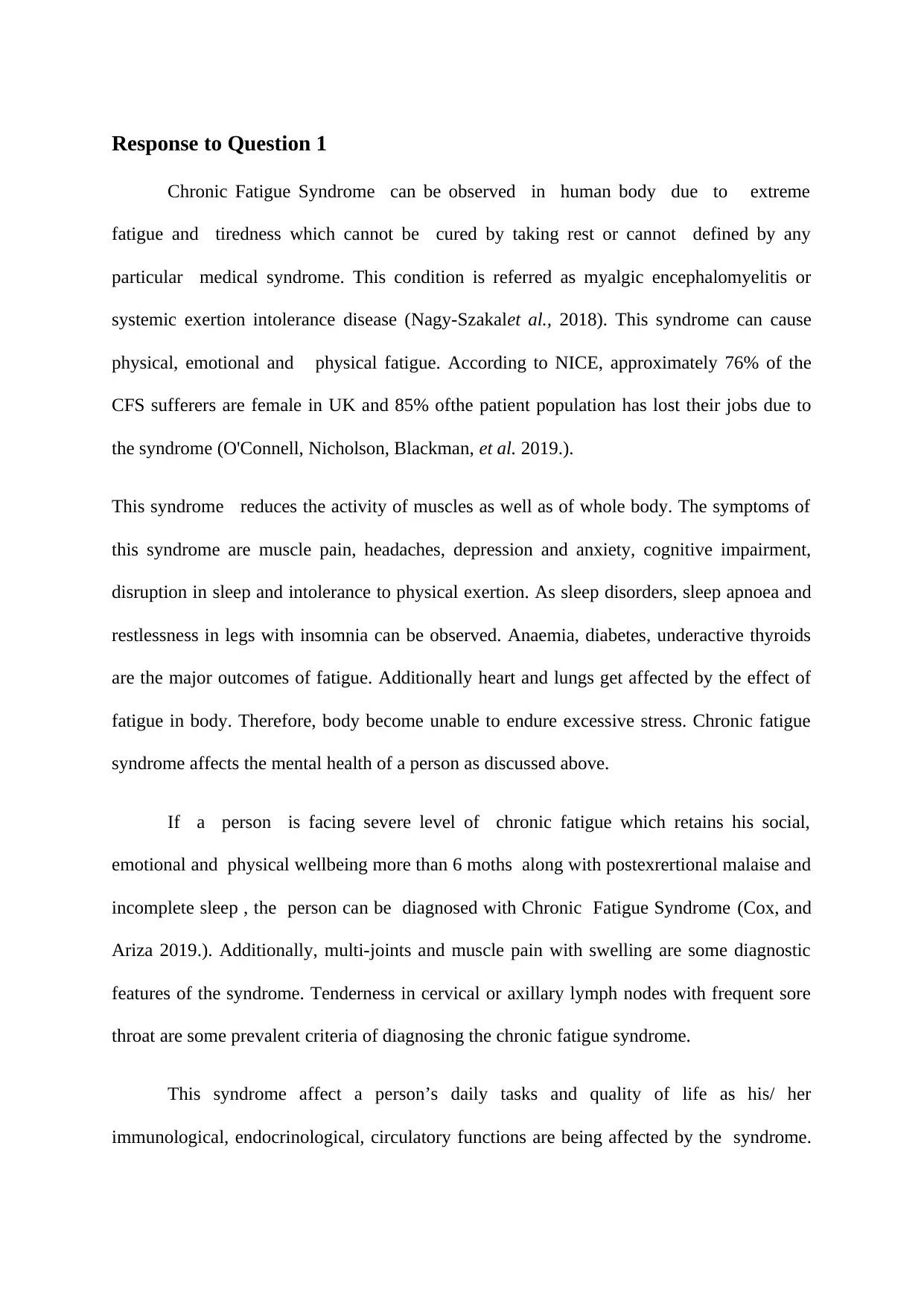
Response to Question 1
Chronic Fatigue Syndrome can be observed in human body due to extreme
fatigue and tiredness which cannot be cured by taking rest or cannot defined by any
particular medical syndrome. This condition is referred as myalgic encephalomyelitis or
systemic exertion intolerance disease (Nagy-Szakalet al., 2018). This syndrome can cause
physical, emotional and physical fatigue. According to NICE, approximately 76% of the
CFS sufferers are female in UK and 85% ofthe patient population has lost their jobs due to
the syndrome (O'Connell, Nicholson, Blackman, et al. 2019.).
This syndrome reduces the activity of muscles as well as of whole body. The symptoms of
this syndrome are muscle pain, headaches, depression and anxiety, cognitive impairment,
disruption in sleep and intolerance to physical exertion. As sleep disorders, sleep apnoea and
restlessness in legs with insomnia can be observed. Anaemia, diabetes, underactive thyroids
are the major outcomes of fatigue. Additionally heart and lungs get affected by the effect of
fatigue in body. Therefore, body become unable to endure excessive stress. Chronic fatigue
syndrome affects the mental health of a person as discussed above.
If a person is facing severe level of chronic fatigue which retains his social,
emotional and physical wellbeing more than 6 moths along with postexrertional malaise and
incomplete sleep , the person can be diagnosed with Chronic Fatigue Syndrome (Cox, and
Ariza 2019.). Additionally, multi-joints and muscle pain with swelling are some diagnostic
features of the syndrome. Tenderness in cervical or axillary lymph nodes with frequent sore
throat are some prevalent criteria of diagnosing the chronic fatigue syndrome.
This syndrome affect a person’s daily tasks and quality of life as his/ her
immunological, endocrinological, circulatory functions are being affected by the syndrome.
Chronic Fatigue Syndrome can be observed in human body due to extreme
fatigue and tiredness which cannot be cured by taking rest or cannot defined by any
particular medical syndrome. This condition is referred as myalgic encephalomyelitis or
systemic exertion intolerance disease (Nagy-Szakalet al., 2018). This syndrome can cause
physical, emotional and physical fatigue. According to NICE, approximately 76% of the
CFS sufferers are female in UK and 85% ofthe patient population has lost their jobs due to
the syndrome (O'Connell, Nicholson, Blackman, et al. 2019.).
This syndrome reduces the activity of muscles as well as of whole body. The symptoms of
this syndrome are muscle pain, headaches, depression and anxiety, cognitive impairment,
disruption in sleep and intolerance to physical exertion. As sleep disorders, sleep apnoea and
restlessness in legs with insomnia can be observed. Anaemia, diabetes, underactive thyroids
are the major outcomes of fatigue. Additionally heart and lungs get affected by the effect of
fatigue in body. Therefore, body become unable to endure excessive stress. Chronic fatigue
syndrome affects the mental health of a person as discussed above.
If a person is facing severe level of chronic fatigue which retains his social,
emotional and physical wellbeing more than 6 moths along with postexrertional malaise and
incomplete sleep , the person can be diagnosed with Chronic Fatigue Syndrome (Cox, and
Ariza 2019.). Additionally, multi-joints and muscle pain with swelling are some diagnostic
features of the syndrome. Tenderness in cervical or axillary lymph nodes with frequent sore
throat are some prevalent criteria of diagnosing the chronic fatigue syndrome.
This syndrome affect a person’s daily tasks and quality of life as his/ her
immunological, endocrinological, circulatory functions are being affected by the syndrome.
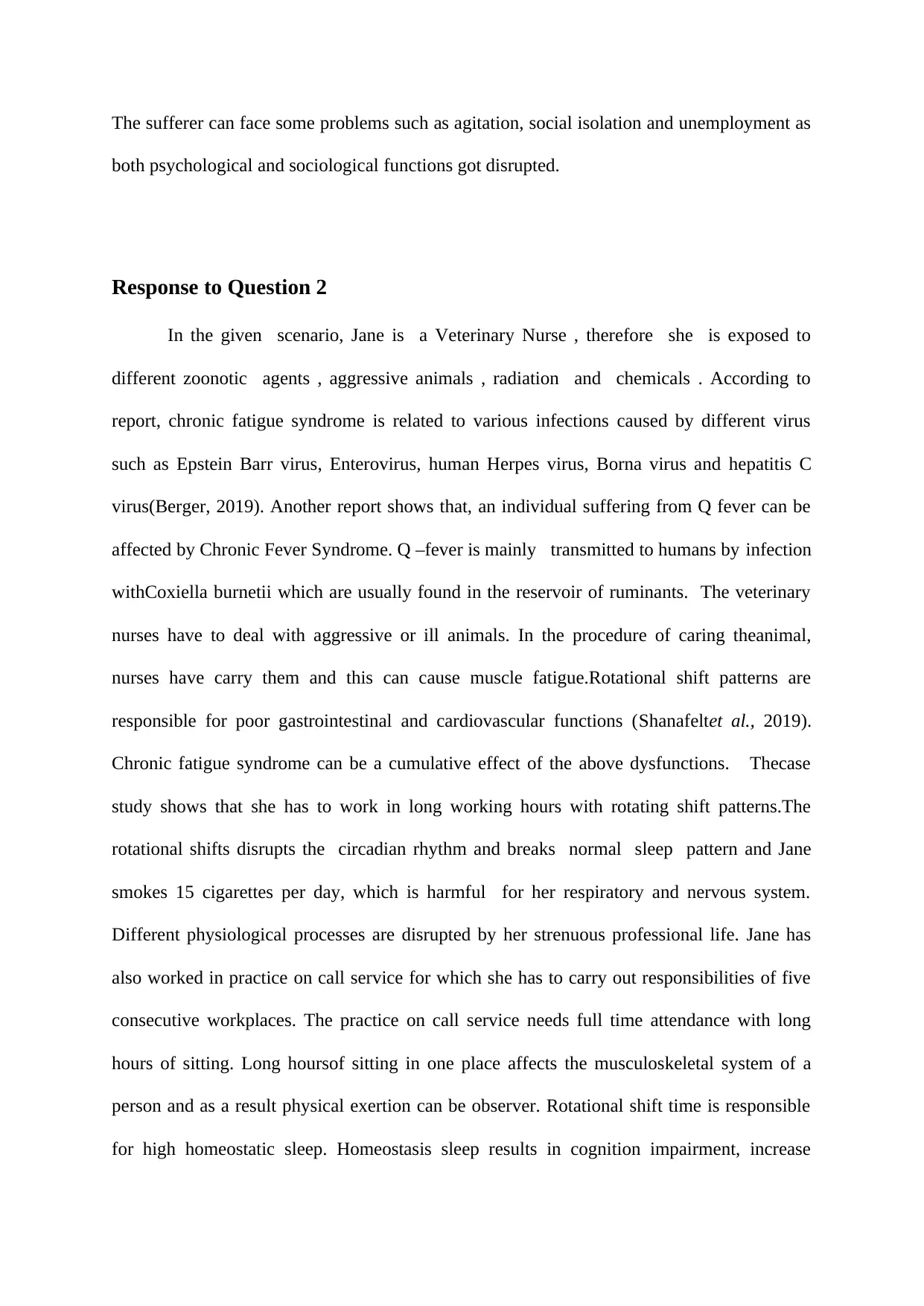
The sufferer can face some problems such as agitation, social isolation and unemployment as
both psychological and sociological functions got disrupted.
Response to Question 2
In the given scenario, Jane is a Veterinary Nurse , therefore she is exposed to
different zoonotic agents , aggressive animals , radiation and chemicals . According to
report, chronic fatigue syndrome is related to various infections caused by different virus
such as Epstein Barr virus, Enterovirus, human Herpes virus, Borna virus and hepatitis C
virus(Berger, 2019). Another report shows that, an individual suffering from Q fever can be
affected by Chronic Fever Syndrome. Q –fever is mainly transmitted to humans by infection
withCoxiella burnetii which are usually found in the reservoir of ruminants. The veterinary
nurses have to deal with aggressive or ill animals. In the procedure of caring theanimal,
nurses have carry them and this can cause muscle fatigue.Rotational shift patterns are
responsible for poor gastrointestinal and cardiovascular functions (Shanafeltet al., 2019).
Chronic fatigue syndrome can be a cumulative effect of the above dysfunctions. Thecase
study shows that she has to work in long working hours with rotating shift patterns.The
rotational shifts disrupts the circadian rhythm and breaks normal sleep pattern and Jane
smokes 15 cigarettes per day, which is harmful for her respiratory and nervous system.
Different physiological processes are disrupted by her strenuous professional life. Jane has
also worked in practice on call service for which she has to carry out responsibilities of five
consecutive workplaces. The practice on call service needs full time attendance with long
hours of sitting. Long hoursof sitting in one place affects the musculoskeletal system of a
person and as a result physical exertion can be observer. Rotational shift time is responsible
for high homeostatic sleep. Homeostasis sleep results in cognition impairment, increase
both psychological and sociological functions got disrupted.
Response to Question 2
In the given scenario, Jane is a Veterinary Nurse , therefore she is exposed to
different zoonotic agents , aggressive animals , radiation and chemicals . According to
report, chronic fatigue syndrome is related to various infections caused by different virus
such as Epstein Barr virus, Enterovirus, human Herpes virus, Borna virus and hepatitis C
virus(Berger, 2019). Another report shows that, an individual suffering from Q fever can be
affected by Chronic Fever Syndrome. Q –fever is mainly transmitted to humans by infection
withCoxiella burnetii which are usually found in the reservoir of ruminants. The veterinary
nurses have to deal with aggressive or ill animals. In the procedure of caring theanimal,
nurses have carry them and this can cause muscle fatigue.Rotational shift patterns are
responsible for poor gastrointestinal and cardiovascular functions (Shanafeltet al., 2019).
Chronic fatigue syndrome can be a cumulative effect of the above dysfunctions. Thecase
study shows that she has to work in long working hours with rotating shift patterns.The
rotational shifts disrupts the circadian rhythm and breaks normal sleep pattern and Jane
smokes 15 cigarettes per day, which is harmful for her respiratory and nervous system.
Different physiological processes are disrupted by her strenuous professional life. Jane has
also worked in practice on call service for which she has to carry out responsibilities of five
consecutive workplaces. The practice on call service needs full time attendance with long
hours of sitting. Long hoursof sitting in one place affects the musculoskeletal system of a
person and as a result physical exertion can be observer. Rotational shift time is responsible
for high homeostatic sleep. Homeostasis sleep results in cognition impairment, increase
⊘ This is a preview!⊘
Do you want full access?
Subscribe today to unlock all pages.

Trusted by 1+ million students worldwide

sleepiness, and propensity for sleep (Hengenet al., 2016). Rotational shift time breaks the
circadian regulation where misalignment of biological day and night, leads to irregular
wakefulness and sleep.
Response to Question 3
Functional approach
The Functional Capacity Evaluation assessed working ability of every employees or
the individuals to understand the quality of performance. FCE's primary objective is to
evaluate a person's ability to participate in work, although other instrumental activities of
daily living that support work performance may also be evaluated. The FCE can evaluate
employees’ capacity to participate in every type of working criteria and health status
(Flaubert, Spicer, Volberding, et al. 2019.) . Background details should be gathered by the
appointed health professionals. The job profile should be evaluated as per the health
condition of the affected person. Different functionality evaluations can be performed to
assess the functional capacity of the person. Hand grip test, Chester step test, carrying tests
are some example of functional capacity tests which can be performed by the occupational
therapists . Questionnaires like Disabilities of the Arm, Shoulder and Hand (DASH)”
questionnaire can be used for assessing the functionality of a person (Sudarshan, Sharma,
Ginn, et al. 2019.). The questionnaires help to moderate the disability of different parts of the
body. Functionality assessment can be evaluated by the standardised functional tests to
ensure valid and trustworthy results to compare different data gathered after performing
different tests.
circadian regulation where misalignment of biological day and night, leads to irregular
wakefulness and sleep.
Response to Question 3
Functional approach
The Functional Capacity Evaluation assessed working ability of every employees or
the individuals to understand the quality of performance. FCE's primary objective is to
evaluate a person's ability to participate in work, although other instrumental activities of
daily living that support work performance may also be evaluated. The FCE can evaluate
employees’ capacity to participate in every type of working criteria and health status
(Flaubert, Spicer, Volberding, et al. 2019.) . Background details should be gathered by the
appointed health professionals. The job profile should be evaluated as per the health
condition of the affected person. Different functionality evaluations can be performed to
assess the functional capacity of the person. Hand grip test, Chester step test, carrying tests
are some example of functional capacity tests which can be performed by the occupational
therapists . Questionnaires like Disabilities of the Arm, Shoulder and Hand (DASH)”
questionnaire can be used for assessing the functionality of a person (Sudarshan, Sharma,
Ginn, et al. 2019.). The questionnaires help to moderate the disability of different parts of the
body. Functionality assessment can be evaluated by the standardised functional tests to
ensure valid and trustworthy results to compare different data gathered after performing
different tests.
Paraphrase This Document
Need a fresh take? Get an instant paraphrase of this document with our AI Paraphraser

Biopsychosocial approach
This approach is an interdisciplinary model which incorporates different types of
professionals in the evaluation of any disorders comparing biological, sociological and
psychological interconnection. To implement the biopsychosocial model, multidisciplinary
teams should be involved. Physical assessment should be performed with the help of doctors
and clinicians. Depression screening tool and mental health assessment tools are used for
the psychodynamic assessment of the employees. Psychologists should be appointed to
evaluate the cognitive wellbeing of the person. The psychologists should collect the every
information from the person to evaluate different thinking patterns and cognitive behaviours
of the patient. Interpersonal relationship should be involved to understand the social skills of
a person (Arnold and Boggs 2019.). Cognitive behavioural assessment should be performed
to understand the social skills of the person.
Formulation of rehabilitation method
To reduce CFS in a person, different exercise can be performed in which both
physiotherapy and psychological therapies are involved. The person should be undergone by
a weekly assessment process with addition of interventions. The step by step technique of
intervening care plan will help to improve the patient condition by setting small goals. Matrix
Rhythm therapy would help her to increase sleep duration and chronic muscle pain (Tang,
Stella, Banks, et al. 2019.). Combination therapy can be suggested to her to reduce pain and
sleep disturbance with antidepressants. Graded exercise therapy can help Jane to improve
her pace and movements with the cognitive behaviours. CBT should be given to her for
improve her interpersonal values and mental well -being. Energy conservational process will
help her in short and long livered movements of hands. Nutritional assistances will support
This approach is an interdisciplinary model which incorporates different types of
professionals in the evaluation of any disorders comparing biological, sociological and
psychological interconnection. To implement the biopsychosocial model, multidisciplinary
teams should be involved. Physical assessment should be performed with the help of doctors
and clinicians. Depression screening tool and mental health assessment tools are used for
the psychodynamic assessment of the employees. Psychologists should be appointed to
evaluate the cognitive wellbeing of the person. The psychologists should collect the every
information from the person to evaluate different thinking patterns and cognitive behaviours
of the patient. Interpersonal relationship should be involved to understand the social skills of
a person (Arnold and Boggs 2019.). Cognitive behavioural assessment should be performed
to understand the social skills of the person.
Formulation of rehabilitation method
To reduce CFS in a person, different exercise can be performed in which both
physiotherapy and psychological therapies are involved. The person should be undergone by
a weekly assessment process with addition of interventions. The step by step technique of
intervening care plan will help to improve the patient condition by setting small goals. Matrix
Rhythm therapy would help her to increase sleep duration and chronic muscle pain (Tang,
Stella, Banks, et al. 2019.). Combination therapy can be suggested to her to reduce pain and
sleep disturbance with antidepressants. Graded exercise therapy can help Jane to improve
her pace and movements with the cognitive behaviours. CBT should be given to her for
improve her interpersonal values and mental well -being. Energy conservational process will
help her in short and long livered movements of hands. Nutritional assistances will support
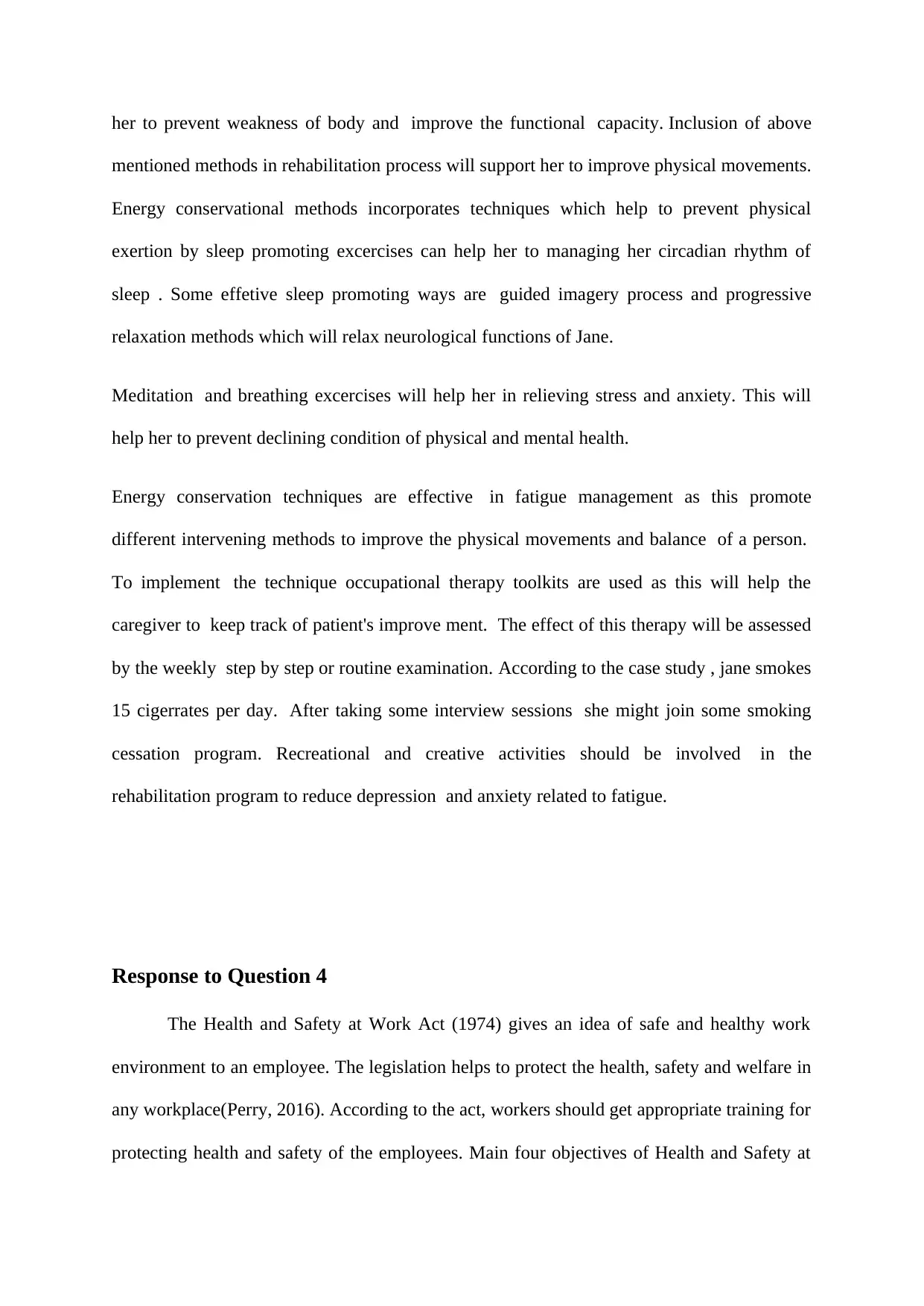
her to prevent weakness of body and improve the functional capacity. Inclusion of above
mentioned methods in rehabilitation process will support her to improve physical movements.
Energy conservational methods incorporates techniques which help to prevent physical
exertion by sleep promoting excercises can help her to managing her circadian rhythm of
sleep . Some effetive sleep promoting ways are guided imagery process and progressive
relaxation methods which will relax neurological functions of Jane.
Meditation and breathing excercises will help her in relieving stress and anxiety. This will
help her to prevent declining condition of physical and mental health.
Energy conservation techniques are effective in fatigue management as this promote
different intervening methods to improve the physical movements and balance of a person.
To implement the technique occupational therapy toolkits are used as this will help the
caregiver to keep track of patient's improve ment. The effect of this therapy will be assessed
by the weekly step by step or routine examination. According to the case study , jane smokes
15 cigerrates per day. After taking some interview sessions she might join some smoking
cessation program. Recreational and creative activities should be involved in the
rehabilitation program to reduce depression and anxiety related to fatigue.
Response to Question 4
The Health and Safety at Work Act (1974) gives an idea of safe and healthy work
environment to an employee. The legislation helps to protect the health, safety and welfare in
any workplace(Perry, 2016). According to the act, workers should get appropriate training for
protecting health and safety of the employees. Main four objectives of Health and Safety at
mentioned methods in rehabilitation process will support her to improve physical movements.
Energy conservational methods incorporates techniques which help to prevent physical
exertion by sleep promoting excercises can help her to managing her circadian rhythm of
sleep . Some effetive sleep promoting ways are guided imagery process and progressive
relaxation methods which will relax neurological functions of Jane.
Meditation and breathing excercises will help her in relieving stress and anxiety. This will
help her to prevent declining condition of physical and mental health.
Energy conservation techniques are effective in fatigue management as this promote
different intervening methods to improve the physical movements and balance of a person.
To implement the technique occupational therapy toolkits are used as this will help the
caregiver to keep track of patient's improve ment. The effect of this therapy will be assessed
by the weekly step by step or routine examination. According to the case study , jane smokes
15 cigerrates per day. After taking some interview sessions she might join some smoking
cessation program. Recreational and creative activities should be involved in the
rehabilitation program to reduce depression and anxiety related to fatigue.
Response to Question 4
The Health and Safety at Work Act (1974) gives an idea of safe and healthy work
environment to an employee. The legislation helps to protect the health, safety and welfare in
any workplace(Perry, 2016). According to the act, workers should get appropriate training for
protecting health and safety of the employees. Main four objectives of Health and Safety at
⊘ This is a preview!⊘
Do you want full access?
Subscribe today to unlock all pages.

Trusted by 1+ million students worldwide

Work etc, Act are safe work place for employment, safe working environment, safety policy
or risk assessment. Adequate health and welfareprovision and consultationare includedin the
work and safety act. The Control of Substances Hazardous to Health Regulations include
different aspects such as identifying the hazardous factors , risk and harm assessment ,
keeping control of the measures which are associated with infection. The regulations are
able to plan emergencies and surveillance in different cases. Management of Health and
Safety at Work Regulation 1999 will help to provide a competent environment for arranging
the control measures for health and safety. The infection and injury control can be managed
by the Management of Health Regulations. According to the case study, the risk of infection
and transmission of pathogens can be controlled by different guidelines of The Control of
Substances Hazardous to Health Regulations 2002 (COSHH)(Thorneset al. 2020). The
mental health of the nurses should be maintained by the employers with the help of
Workplace mental health and wellbeing policy. The policy helps the organisation to assess
the risk and probable hazards in the workplace. The risk factors such as long working hours
and rotational shifts with employee satisfaction should be assessed with the proposed
guidelines under the mental health policy.
or risk assessment. Adequate health and welfareprovision and consultationare includedin the
work and safety act. The Control of Substances Hazardous to Health Regulations include
different aspects such as identifying the hazardous factors , risk and harm assessment ,
keeping control of the measures which are associated with infection. The regulations are
able to plan emergencies and surveillance in different cases. Management of Health and
Safety at Work Regulation 1999 will help to provide a competent environment for arranging
the control measures for health and safety. The infection and injury control can be managed
by the Management of Health Regulations. According to the case study, the risk of infection
and transmission of pathogens can be controlled by different guidelines of The Control of
Substances Hazardous to Health Regulations 2002 (COSHH)(Thorneset al. 2020). The
mental health of the nurses should be maintained by the employers with the help of
Workplace mental health and wellbeing policy. The policy helps the organisation to assess
the risk and probable hazards in the workplace. The risk factors such as long working hours
and rotational shifts with employee satisfaction should be assessed with the proposed
guidelines under the mental health policy.
Paraphrase This Document
Need a fresh take? Get an instant paraphrase of this document with our AI Paraphraser
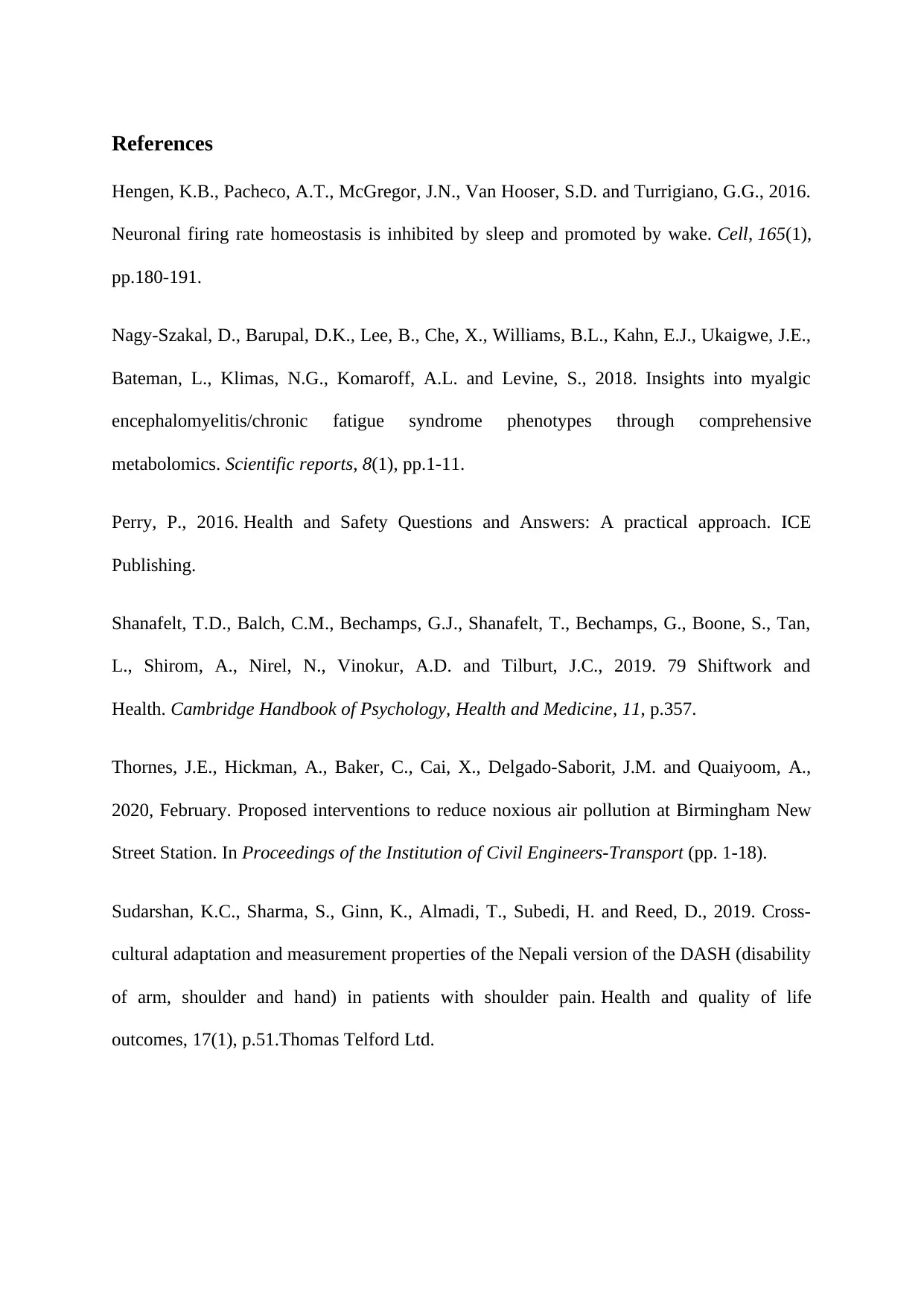
References
Hengen, K.B., Pacheco, A.T., McGregor, J.N., Van Hooser, S.D. and Turrigiano, G.G., 2016.
Neuronal firing rate homeostasis is inhibited by sleep and promoted by wake. Cell, 165(1),
pp.180-191.
Nagy-Szakal, D., Barupal, D.K., Lee, B., Che, X., Williams, B.L., Kahn, E.J., Ukaigwe, J.E.,
Bateman, L., Klimas, N.G., Komaroff, A.L. and Levine, S., 2018. Insights into myalgic
encephalomyelitis/chronic fatigue syndrome phenotypes through comprehensive
metabolomics. Scientific reports, 8(1), pp.1-11.
Perry, P., 2016. Health and Safety Questions and Answers: A practical approach. ICE
Publishing.
Shanafelt, T.D., Balch, C.M., Bechamps, G.J., Shanafelt, T., Bechamps, G., Boone, S., Tan,
L., Shirom, A., Nirel, N., Vinokur, A.D. and Tilburt, J.C., 2019. 79 Shiftwork and
Health. Cambridge Handbook of Psychology, Health and Medicine, 11, p.357.
Thornes, J.E., Hickman, A., Baker, C., Cai, X., Delgado-Saborit, J.M. and Quaiyoom, A.,
2020, February. Proposed interventions to reduce noxious air pollution at Birmingham New
Street Station. In Proceedings of the Institution of Civil Engineers-Transport (pp. 1-18).
Sudarshan, K.C., Sharma, S., Ginn, K., Almadi, T., Subedi, H. and Reed, D., 2019. Cross-
cultural adaptation and measurement properties of the Nepali version of the DASH (disability
of arm, shoulder and hand) in patients with shoulder pain. Health and quality of life
outcomes, 17(1), p.51.Thomas Telford Ltd.
Hengen, K.B., Pacheco, A.T., McGregor, J.N., Van Hooser, S.D. and Turrigiano, G.G., 2016.
Neuronal firing rate homeostasis is inhibited by sleep and promoted by wake. Cell, 165(1),
pp.180-191.
Nagy-Szakal, D., Barupal, D.K., Lee, B., Che, X., Williams, B.L., Kahn, E.J., Ukaigwe, J.E.,
Bateman, L., Klimas, N.G., Komaroff, A.L. and Levine, S., 2018. Insights into myalgic
encephalomyelitis/chronic fatigue syndrome phenotypes through comprehensive
metabolomics. Scientific reports, 8(1), pp.1-11.
Perry, P., 2016. Health and Safety Questions and Answers: A practical approach. ICE
Publishing.
Shanafelt, T.D., Balch, C.M., Bechamps, G.J., Shanafelt, T., Bechamps, G., Boone, S., Tan,
L., Shirom, A., Nirel, N., Vinokur, A.D. and Tilburt, J.C., 2019. 79 Shiftwork and
Health. Cambridge Handbook of Psychology, Health and Medicine, 11, p.357.
Thornes, J.E., Hickman, A., Baker, C., Cai, X., Delgado-Saborit, J.M. and Quaiyoom, A.,
2020, February. Proposed interventions to reduce noxious air pollution at Birmingham New
Street Station. In Proceedings of the Institution of Civil Engineers-Transport (pp. 1-18).
Sudarshan, K.C., Sharma, S., Ginn, K., Almadi, T., Subedi, H. and Reed, D., 2019. Cross-
cultural adaptation and measurement properties of the Nepali version of the DASH (disability
of arm, shoulder and hand) in patients with shoulder pain. Health and quality of life
outcomes, 17(1), p.51.Thomas Telford Ltd.
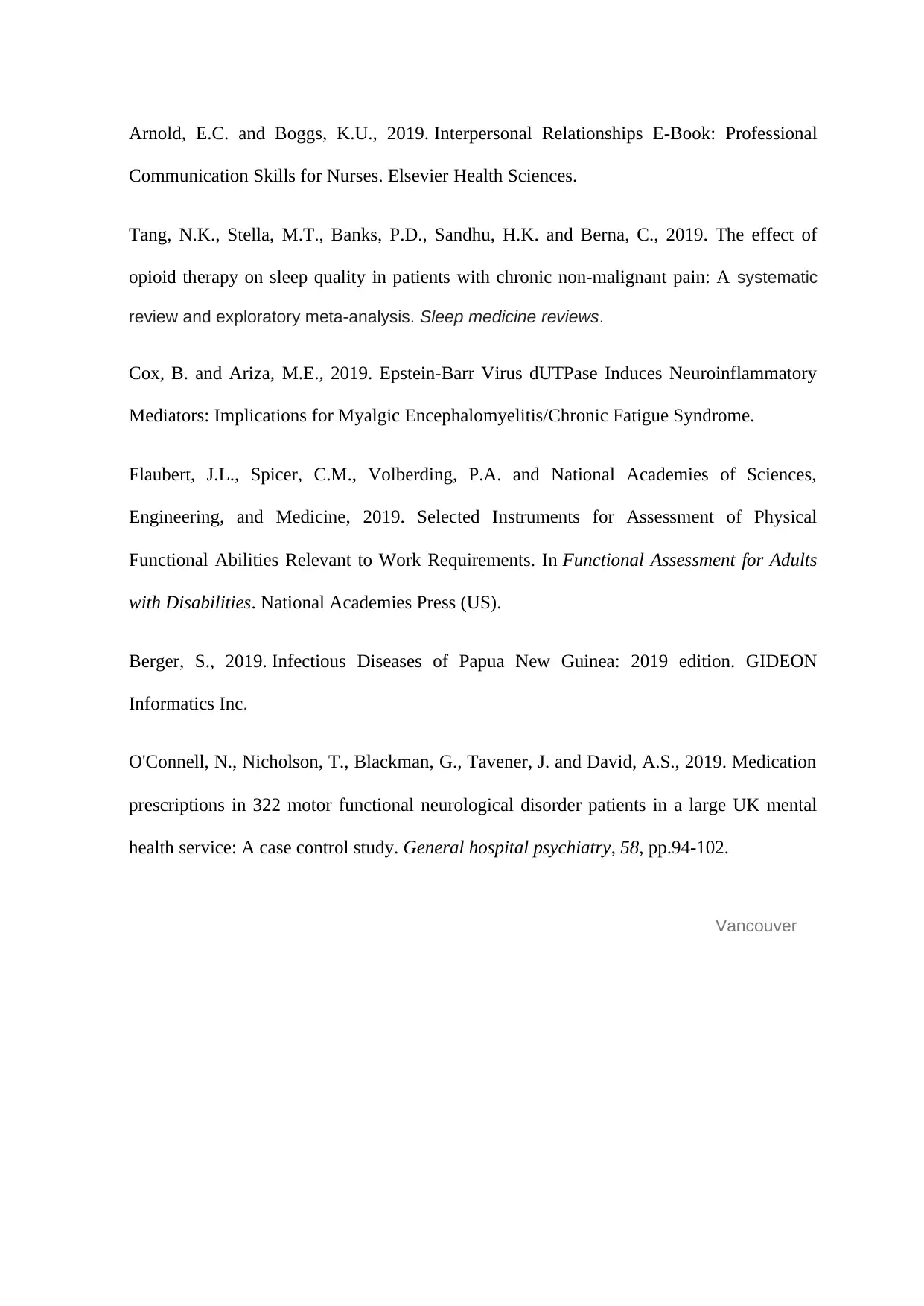
Arnold, E.C. and Boggs, K.U., 2019. Interpersonal Relationships E-Book: Professional
Communication Skills for Nurses. Elsevier Health Sciences.
Tang, N.K., Stella, M.T., Banks, P.D., Sandhu, H.K. and Berna, C., 2019. The effect of
opioid therapy on sleep quality in patients with chronic non-malignant pain: A systematic
review and exploratory meta-analysis. Sleep medicine reviews.
Cox, B. and Ariza, M.E., 2019. Epstein-Barr Virus dUTPase Induces Neuroinflammatory
Mediators: Implications for Myalgic Encephalomyelitis/Chronic Fatigue Syndrome.
Flaubert, J.L., Spicer, C.M., Volberding, P.A. and National Academies of Sciences,
Engineering, and Medicine, 2019. Selected Instruments for Assessment of Physical
Functional Abilities Relevant to Work Requirements. In Functional Assessment for Adults
with Disabilities. National Academies Press (US).
Berger, S., 2019. Infectious Diseases of Papua New Guinea: 2019 edition. GIDEON
Informatics Inc.
O'Connell, N., Nicholson, T., Blackman, G., Tavener, J. and David, A.S., 2019. Medication
prescriptions in 322 motor functional neurological disorder patients in a large UK mental
health service: A case control study. General hospital psychiatry, 58, pp.94-102.
Vancouver
Communication Skills for Nurses. Elsevier Health Sciences.
Tang, N.K., Stella, M.T., Banks, P.D., Sandhu, H.K. and Berna, C., 2019. The effect of
opioid therapy on sleep quality in patients with chronic non-malignant pain: A systematic
review and exploratory meta-analysis. Sleep medicine reviews.
Cox, B. and Ariza, M.E., 2019. Epstein-Barr Virus dUTPase Induces Neuroinflammatory
Mediators: Implications for Myalgic Encephalomyelitis/Chronic Fatigue Syndrome.
Flaubert, J.L., Spicer, C.M., Volberding, P.A. and National Academies of Sciences,
Engineering, and Medicine, 2019. Selected Instruments for Assessment of Physical
Functional Abilities Relevant to Work Requirements. In Functional Assessment for Adults
with Disabilities. National Academies Press (US).
Berger, S., 2019. Infectious Diseases of Papua New Guinea: 2019 edition. GIDEON
Informatics Inc.
O'Connell, N., Nicholson, T., Blackman, G., Tavener, J. and David, A.S., 2019. Medication
prescriptions in 322 motor functional neurological disorder patients in a large UK mental
health service: A case control study. General hospital psychiatry, 58, pp.94-102.
Vancouver
⊘ This is a preview!⊘
Do you want full access?
Subscribe today to unlock all pages.

Trusted by 1+ million students worldwide
1 out of 9
Related Documents
Your All-in-One AI-Powered Toolkit for Academic Success.
+13062052269
info@desklib.com
Available 24*7 on WhatsApp / Email
![[object Object]](/_next/static/media/star-bottom.7253800d.svg)
Unlock your academic potential
Copyright © 2020–2025 A2Z Services. All Rights Reserved. Developed and managed by ZUCOL.




